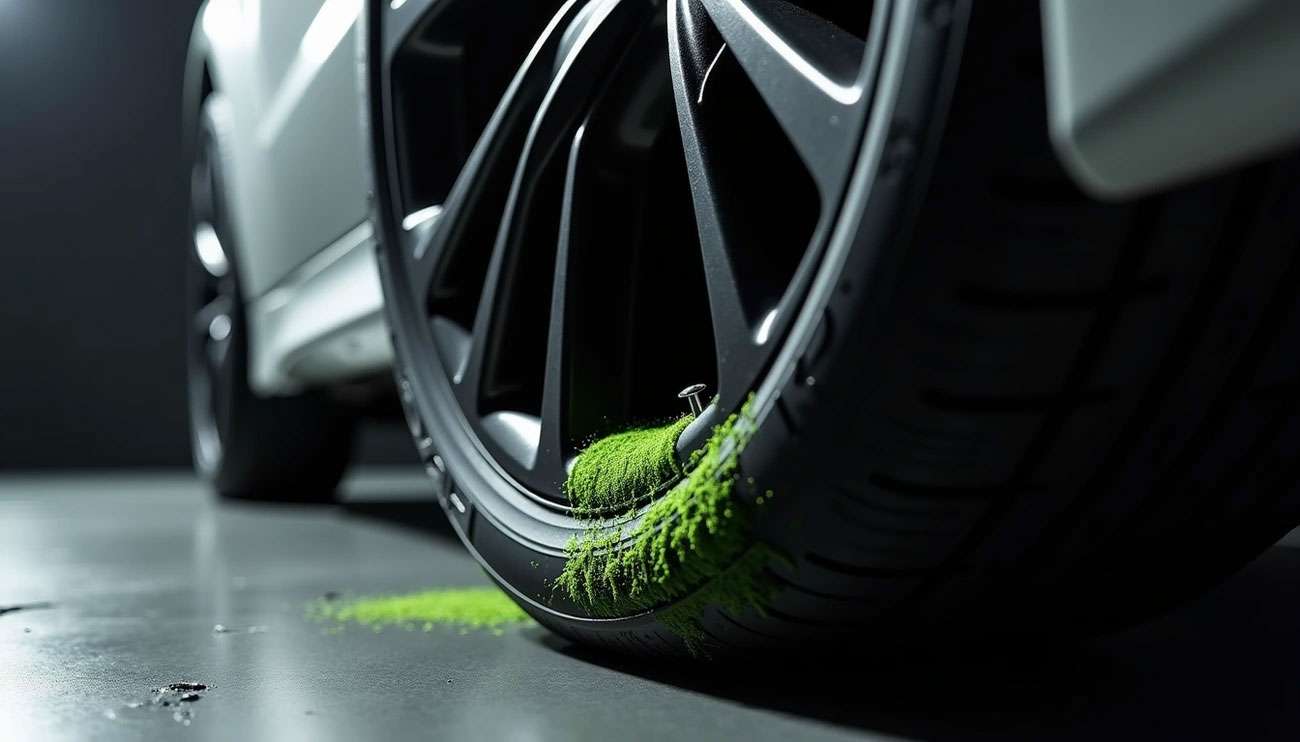
Self-sealing and puncture-resistant tires are changing how drivers handle one of the road's most common problems. These specialized tires automatically seal small punctures as they happen, keeping you moving when nails, screws, or other sharp objects would normally leave you stranded.
Modern self-sealing tires handle punctures up to ¼ inch (6mm) in diameter with impressive success rates. MICHELIN SelfSeal technology seals 90% of punctures you're likely to encounter, while Continental ContiSeal™ prevents up to 80% of tire damage scenarios. Pirelli Seal Inside™ covers 85% of typical puncture causes. While these tires won't replace regular tire maintenance or protect against major damage, they provide a crucial safety net that keeps you on the road.
Puncture-resistant tires deliver benefits that go well beyond preventing flats. You get enhanced safety during highway driving, increased durability for long-term value, peace of mind on every trip, and cost savings over the tire's lifetime. These tires typically outlast standard tires because they resist the everyday hazards that cause premature tire failure. For drivers who frequently encounter construction zones, urban debris, or highway hazards, self-sealing tires offer a practical solution that eliminates the fear of being stuck with a flat tire at the worst possible moment.

Image Source: SpringerLink
Understanding how self-sealing tires actually function helps explain why they've become essential safety equipment for many drivers. Unlike standard tires that immediately lose air when punctured, self-sealing tires contain specialized internal components that react instantly to puncture events.
The self-sealing process starts the moment a nail or screw penetrates the tire. A viscous, sticky material layer covers the entire tread width inside the tire. This sealant layer stays soft and flexible across all temperature ranges and driving conditions you'll encounter. When a sharp object pierces through the rubber and structural belts, internal air pressure forces this specialized material directly into the opening.
The sealant flows to the puncture point within seconds, creating an airtight seal that stops air loss. The process works whether the puncturing object stays lodged in the tire or falls out completely. Continental and other manufacturers have engineered specialized coatings that seal holes from multiple objects without compromising internal pressure.
Demonstrations of this technology show nails entering and exiting a tire while it stays fully inflated - clear evidence that self-sealing tires perform effectively in actual driving conditions. The entire sealing process happens instantaneously, often without drivers realizing a puncture occurred.
Self-sealing tires have specific performance boundaries despite their impressive capabilities. Most handle punctures up to 5mm in diameter, though advanced models like MICHELIN Selfseal manage punctures up to 6mm (¼ inch). This size limitation aligns with professional tire industry standards that establish 6mm as the maximum repairable injury size for passenger tires.
The technology primarily works on tread area punctures. The sealant layer typically doesn't extend to sidewalls, making sidewall punctures problematic. Deep cuts across the tread or larger punctures beyond the size threshold cannot be sealed.
Self-sealing tires close puncture wounds and prevent air loss, but professional inspection and proper repair remain necessary after any puncture event. The technology serves as an immediate safety measure rather than a permanent solution - allowing safe driving until proper service can be completed.
Self-sealing tires and run-flat tires solve the same problem using completely different methods. Run-flat tires feature reinforced, thicker sidewalls and sometimes internal support rings that enable continued driving after complete air pressure loss. They're designed to support vehicle weight for limited distances (typically up to 50 miles) after punctures.
Self-sealing tires focus on preventing air loss entirely. They maintain normal sidewall construction while incorporating the specialized sealant layer. This fundamental difference creates several practical distinctions:
Ride Quality: Self-sealing tires provide more comfortable rides since they don't require the stiffer sidewall construction of run-flats
Post-Puncture Performance: Run-flats allow limited driving after complete pressure loss, while self-sealing tires maintain normal speed and performance when punctures are successfully sealed
Damage Coverage: Run-flats handle sidewall damage and larger punctures due to reinforced construction, whereas self-sealing tires work best with smaller tread area punctures
Both technologies represent significant advances over conventional tires, with each offering distinct advantages based on driver priorities and typical driving conditions.
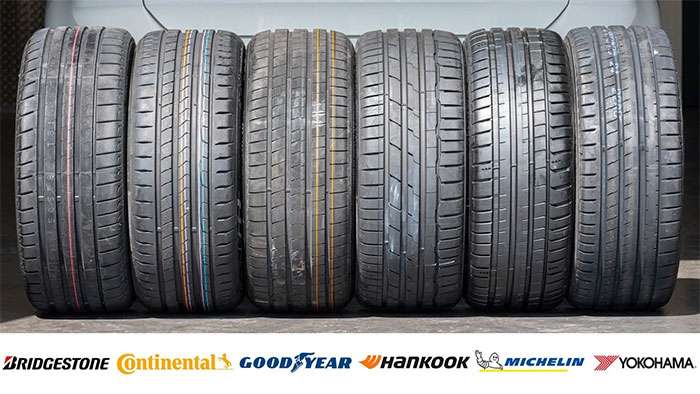
Image Source: YouTube
The tire industry's top manufacturers have developed cutting-edge self-sealing technologies, each offering unique advantages for drivers seeking puncture protection. Understanding these different approaches helps you choose the best solution for your specific driving needs and vehicle requirements.
MICHELIN SelfSeal stands out with its natural rubber sealant formulation, which the company designed for environmental sustainability without sacrificing performance. This technology handles punctures up to 6mm in diameter, placing it among the most capable systems available. The 2020 Ford Explorer became the first vehicle to feature MICHELIN SelfSeal as factory equipment, demonstrating manufacturer confidence in this technology.
Continental ContiSeal™ takes a different engineering approach with its specialized inner sealant layer. Continental backs their system with a strong guarantee that 80% of all punctures will be successfully sealed. We've seen this technology applied across multiple Continental tire lines, making it both accessible and cost-effective for drivers wanting proven puncture protection.
The key difference lies in their design philosophy. MICHELIN emphasizes eco-friendly materials with their natural rubber compound, while Continental focuses on proven reliability with their comprehensive repair guarantee.
Pirelli Seal Inside™ offers a significant practical advantage through its universal compatibility design. Unlike some specialized tire technologies that require specific rims or Tire Pressure Monitoring Systems, Seal Inside™ works with standard equipment. This means you can mount these tires on any vehicle with compatible sizes, dramatically expanding your installation options.
Pirelli's system successfully prevents air loss in approximately 85% of puncture scenarios. The technology uses a special sealing layer positioned precisely within the tread area. This material creates an effective barrier whether the puncturing object stays in the tire or gets removed during driving.
The automatic sealing process works through a mastic material that adheres to puncturing objects, forming an immediate seal. When the object falls out, the same mastic closes the hole completely. Many drivers never realize a puncture occurred because the system works so quickly.
For those considering self-sealing tire options, Performance Plus Tire carries various models with expert guidance to help you select the right technology for your vehicle.
Goodyear DuraSeal represents one of the most established self-sealing solutions, featuring a gel-like, solvent-free compound integrated into the tire's inner liner. This system instantly seals punctures up to 1/4-inch (approximately 6.35mm) in the tread area.
DuraSeal's exceptional durability sets it apart from competitors. Controlled testing showed tires withstanding up to 50 punctures while maintaining air pressure. The compound remains effective through multiple retreading cycles, providing outstanding value for commercial fleets and high-mileage drivers.
Hankook SEALGUARD® brings newer technology to the market with a tacky, viscous material applied from shoulder to shoulder inside the tire. This system seals punctures up to 5mm in diameter, covering most common road hazards drivers encounter.
Currently, Hankook offers SEALGUARD® in the Ventus S1 noble 2 pattern for sizes 255/40R20 and 285/35R20. The company continues expanding size availability, showing their commitment to making this technology more widely accessible.
Each manufacturer brings distinct strengths to puncture protection. Whether you prioritize environmental considerations, proven reliability, universal compatibility, or commercial durability, there's a self-sealing technology engineered to meet your specific requirements.
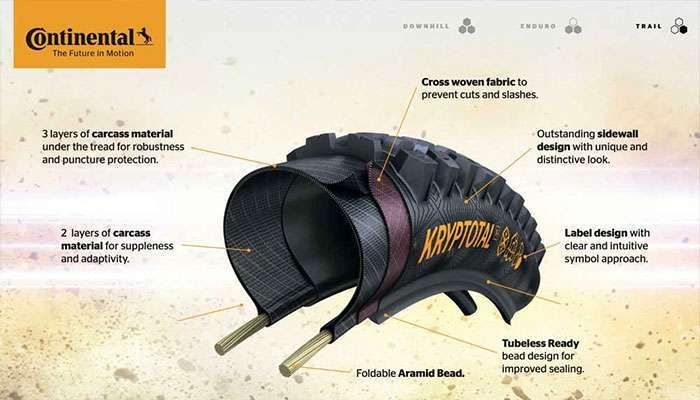
Image Source: Two Wheel Tales
The construction of puncture-resistant tires involves sophisticated engineering that goes far beyond basic tire manufacturing. These tires incorporate three essential design elements that work together to create superior durability and performance under challenging conditions.
Puncture-resistant tires feature substantially stronger sidewalls than standard tires. These reinforced sidewalls use multiple layers of specialized rubber, fabric, and reinforcement materials to create exceptional structural integrity. The engineering serves several critical purposes: enhanced resistance to sharp objects from road debris, improved load-bearing capacity during air pressure loss, and extended tire life through better impact resistance.
When a tire loses air pressure, these reinforced sidewalls continue supporting the vehicle's weight, preventing complete tire collapse. This allows drivers to maintain control during emergency situations and reach safety. The specialized construction also resists the impact and abrasion damage that typically causes premature tire failure.
The incorporation of Kevlar and aramid fibers represents advanced materials engineering applied to tire construction. Kevlar, famous for bulletproof vest applications, brings exceptional puncture, abrasion, and tear resistance to tire sidewalls. These high-strength fibers create protective barriers without adding significant weight to the tire.
Aramid fibers deliver particularly impressive performance benefits. When integrated with rubber compounds, aramid provides structural strength similar to fiberglass while maintaining tire flexibility. This creates tires with five times more impact resistance than carbon fiber reinforced alternatives. The lightweight nature of aramid fibers (density around 1.45 g/cm³) provides additional advantages:
Reduced rotational weight improves fuel efficiency
Better dimensional stability at high speeds and temperatures
Enhanced handling without compromising ride comfort
Major tire manufacturers have been using aramid fiber reinforcement since 2014, with proven durability improvements that maintain performance standards.
The tread area features specially formulated rubber compounds designed for maximum durability. These formulations typically combine synthetic rubber (60-70%) with carbon black, silica, and other performance-enhancing additives. The precise material science creates tread surfaces with superior cut, chip, and wear resistance.
Tread pattern design plays an equally important role in puncture resistance. Engineers use deeper grooves, larger tread blocks, and strategic patterns that deflect sharp objects and distribute impact forces across wider areas. When nails or similar hazards contact the tire, these patterns redirect pressure away from vulnerable points.
Modern tread compounds deliver multiple performance benefits. Enhanced wear resistance extends usable tire life significantly, while maintaining excellent traction across various driving conditions. For commercial and off-road applications, specialized chip and cut resistant formulations provide exceptional service life in harsh environments.
These three core construction features—reinforced sidewalls, military-grade fiber integration, and advanced tread engineering—create tires capable of handling conditions that would destroy conventional tires, all while maintaining normal weight and ride characteristics.
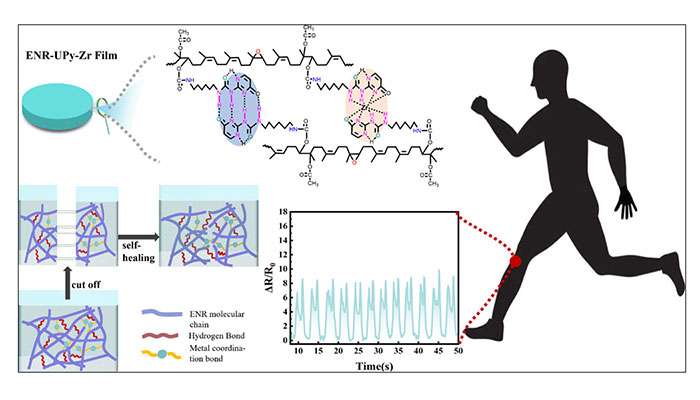
Image Source: ACS Publications - American Chemical Society
Current self-sealing technologies represent just the beginning. Researchers are developing truly self-healing rubber that repairs itself at the molecular level, much like biological tissue regenerates after injury. This represents a fundamental shift from simply sealing punctures to actually rebuilding damaged tire structure.
The science behind self-healing rubber centers on reversible hydrogen bonds integrated throughout the polymer matrix. When damage occurs, these specialized bonds break and then spontaneously reconnect, essentially stitching the material back together. Individual hydrogen bonds are relatively weak—less than 40 kJ/mol compared to covalent bonds at approximately 400 kJ/mol—but their collective strength creates remarkable healing properties.
Scientists have discovered that incorporating multiple hydrogen-bonding units such as ureidopyrimidinone (UPy) dramatically enhances self-healing capabilities. These units create powerful connections that can be precisely tuned for optimal performance. Strategic positioning of these hydrogen-bonding units throughout the rubber compound creates a dynamic system that responds to damage automatically.
For tire applications, researchers explore hybrid networks that combine permanent covalent bonds for structural integrity with reversible hydrogen bonds for healing capability. This balanced approach creates materials with sufficient mechanical strength for tire use without sacrificing self-healing properties.
Self-healing rubber systems function through either room temperature activation or heat-assisted processes. Room temperature healing offers immediate convenience with no external energy requirements. Laboratory testing shows some hydrogen-bonded elastomers achieve impressive 80% mechanical recovery after just 24 hours at ambient temperature.
Heat-activated systems typically deliver faster, more complete repairs. When solid-like hydrogels containing hydrogen bonds were heated to 50°C, they exhibited accelerated self-healing behavior. Surprisingly, samples tested at extremely low temperatures (-30°C) demonstrated stronger healing than those at room temperature, with healed strength reaching above 3.5 MPa.
Practical applications will depend on specific use cases. Consumer vehicles might benefit from room-temperature healing for convenience, while commercial fleets could utilize heat-activated systems during scheduled maintenance for more thorough repairs.
Despite promising advances, significant obstacles remain before self-healing tires become mainstream. Current prototype materials require up to 8 days to fully repair punctures, far too slow for safety-critical applications. The technology remains expensive and not yet viable for mass production.
Finding the optimal balance between self-healing capabilities and traditional tire performance metrics presents another significant challenge. Self-healing rubber must maintain adequate traction, grip, and wear resistance while preserving its repair functionality. Current implementations often show reduced mechanical properties compared to conventional rubber.
Recent research demonstrates promising progress. Scientists have successfully fabricated self-healing natural rubber based on reversible metal-thiolate ionic networks that recovers initial properties at room temperature without external stimuli. Testing shows self-healing rubber tape with specific recycled rubber content achieved 100% recovery from punctures with nail diameters below 2.5mm, though healing efficiency decreased to 87-97% with larger 3.4-4.0mm punctures.
As research progresses, these materials may eventually eliminate flat tires entirely, changing our relationship with one of driving's most common inconveniences.
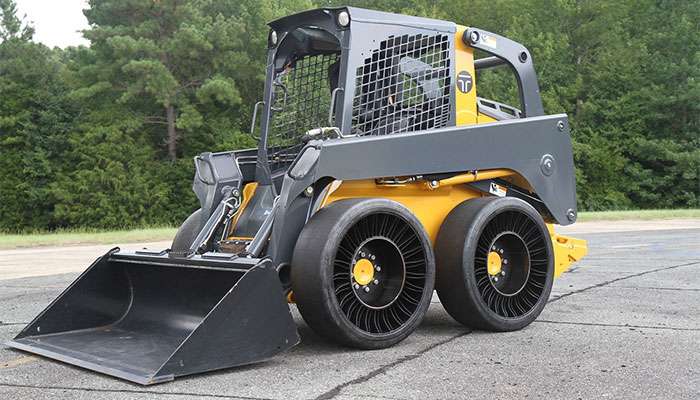
Image Source: Motor Authority
While self-sealing technologies handle punctures after they happen, innovative tire designs are eliminating the flat tire problem entirely. Two distinct approaches are leading this charge—airless tires that remove air pressure from the equation and smart tires that monitor and adjust themselves automatically.
The MICHELIN X TWEEL takes a radical approach to tire design by combining the tire and wheel into a single unit that can't go flat. Instead of relying on air pressure, Tweels use flexible polyurethane spokes that connect directly to the hub. When you hit a pothole or debris, these spokes bend and flex to absorb the impact while maintaining their shape. The poly-resin spokes include a unique energy transfer system that reduces the bouncing you'd normally feel with regular tires, giving you smoother handling.
The engineering behind Tweels includes four main components: a solid hub for mounting, flexible spokes that carry the vehicle's weight, a semi-rigid shear beam for stability, and conventional rubber tread for road grip. Hankook's iFlex airless tire has proven this concept works at highway speeds, successfully testing at 80 mph while matching traditional tires in durability, hardness, stability, and handling tests.
Smart tire technology represents another path toward eliminating tire-related breakdowns. Modern sensors go far beyond basic pressure alerts—they monitor tire temperature, detect small punctures before they become problems, and warn you about potential hazards before they cause damage. Continental's ContiSense technology embeds sensors directly in a conductive rubber layer to continuously measure inflation pressure, tread depth, tire temperature, and road conditions.
Future smart tires will take care of themselves without any input from you. These intelligent systems will automatically adjust air pressure based on your driving conditions, weather, and road surface. This constant optimization improves both safety and fuel efficiency while reducing maintenance needs.
Military applications show the real-world advantages of airless tire technology. The U.S. Army tested Tweels on MRZR vehicles specifically to eliminate flat tire vulnerabilities in combat situations. These tires keep functioning even after taking significant damage—military tests included drilling holes to simulate bullet impacts. During jungle terrain testing, Tweels adapted to multiple surface types while lasting three times longer than conventional military tires.
Construction sites present similar challenges where debris regularly destroys conventional tires. While solid rubber tires have been the traditional solution, airless designs like the Tweel offer much better ride quality without sacrificing puncture immunity. For unmanned ground vehicles where tire changes are impossible, Michelin's non-pneumatic tires provide the reliability that remote operations demand.
The self-sealing tire market is experiencing remarkable growth, currently valued at approximately $20.76 billion in 2024 and projected to reach $22.56 billion in 2025. Industry experts anticipate this sector expanding to an impressive $47.73 billion by 2034, representing a compound annual growth rate of 8.68%.
Today's consumers have access to self-sealing tires through dealerships, retail stores, and online platforms. At Performance Plus Tire, we offer access to multiple brands with expert guidance on selecting the right model for your specific vehicle needs. Market penetration continues to grow despite higher manufacturing and retail costs, making these advanced tires increasingly accessible to everyday drivers.
Electric vehicles have become major adopters of self-sealing technology. Continental currently provides original equipment for 9 out of 10 electric vehicles, demonstrating widespread manufacturer confidence in this technology. MICHELIN Selfseal technology comes standard on several 2020+ models including the Ford Explorer, Cadillac CT5, Chevy Bolt, and Chrysler Pacifica. The heavier weight of electric vehicles makes puncture resistance especially valuable for these applications.
Self-sealing tires carry a higher upfront cost compared to conventional options. However, their ability to prevent flats and reduce maintenance needs makes them a smart long-term investment. The increased lifespan and reduced replacement frequency often offset the initial price difference, delivering real value for drivers who want reliable performance.
When choosing self-sealing tires, consider your driving conditions, vehicle type, and budget. Our experts can help you find the best selection at competitive prices to meet your specific needs.
Self-sealing and puncture-resistant tires have proven their worth as essential safety upgrades for modern vehicles. These technologies effectively handle the vast majority of punctures you're likely to encounter, keeping you moving when conventional tires would leave you stranded on the roadside.
The engineering behind these tires shows remarkable innovation. From MICHELIN's environmentally conscious compounds to Continental's proven reliability guarantees, each manufacturer brings unique strengths to solving flat tire problems. The integration of military-grade materials like Kevlar and aramid fibers creates protection that goes far beyond what standard tires can offer.
Future developments in self-healing rubber technology promise even greater advances. While current prototypes still need refinement for practical use, the potential to eliminate flat tires entirely represents the next major step in tire evolution.
Airless tire designs and smart sensor technology offer additional paths toward maintenance-free driving. These innovations, already successful in specialized applications, may soon become standard equipment for everyday vehicles.
The market growth projections reflect real consumer demand for these safety features. While self-sealing tires require a higher initial investment, they deliver long-term value through reduced maintenance, fewer emergency situations, and extended tire life. At Performance Plus Tire, our experts can help you select the right puncture-resistant option for your specific vehicle and driving needs.
Electric vehicles and SUVs continue driving adoption of these technologies as standard equipment. For anyone seeking improved safety, convenience, and peace of mind on the road, self-sealing and puncture-resistant tires represent a smart upgrade that pays dividends every mile you drive.
Modern self-sealing and puncture-resistant tires are revolutionizing road safety by automatically handling most common tire damage scenarios.
• Self-sealing tires prevent 80-90% of flats by using internal sealant layers that instantly seal punctures up to 6mm diameter in the tread area.
• Major brands offer proven technologies including MICHELIN SelfSeal, Continental ContiSeal™, and Pirelli Seal Inside™, each with unique approaches and compatibility features.
• Advanced construction uses military-grade materials like Kevlar and aramid fibers in reinforced sidewalls, creating five times more impact resistance than standard tires.
• Future self-healing rubber will repair at molecular level using reversible hydrogen bonds, though current prototypes require 8 days for complete healing.
• Market growth is accelerating rapidly with the sector projected to reach $47.73 billion by 2034, driven by electric vehicle adoption and consumer demand for reliability.
While initially more expensive than conventional tires, these technologies deliver long-term value through reduced maintenance, fewer roadside emergencies, and extended tire life. As electric vehicles increasingly adopt these systems as standard equipment, self-sealing tires are becoming essential for modern driving safety and convenience.
Yes, self-sealing tires are readily available from multiple reputable manufacturers. You can purchase them through local tire shops or directly from brands like Michelin, Pirelli, Continental, Hankook, Bridgestone, and Goodyear, each offering their own proprietary self-sealing technology.
Self-healing tubeless tires contain an extra layer of sealant inside the tire. When a puncture occurs, this sealant immediately flows into the hole, creating a seal that prevents air loss. This technology allows the tire to continue functioning normally with little to no air pressure loss.
While self-sealing tires may have a higher upfront cost, they often prove cost-effective in the long run. They reduce the risk of roadside failures, minimize towing costs, and can prevent the need for premature tire replacements caused by neglected flat tires, ultimately saving money and providing peace of mind.
Many electric vehicles, including some Tesla models, come equipped with self-sealing tire technology. This feature allows drivers to continue for many miles before the tire goes completely flat, which is particularly useful since many new cars, including EVs, don't come with spare tires to save space and weight.
Self-sealing tires offer several key benefits: they can prevent up to 90% of common punctures, allow continued driving after most punctures occur, reduce the need for roadside tire changes, extend overall tire life, and provide enhanced safety and convenience for drivers, especially in areas prone to road debris or during long trips.